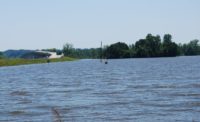The Environmental Protection Agency has blocked a Corps of Engineers flood-control project in the Mississippi Delta because it has determined that the plan would have harmed wetlands and wildlife in the area. EPA's final decision, announced Sept. 2, on the $220-million Yazoo Backwater Project is a victory for environmental groups. But the project's local sponsor, the Mississippi Levee Board, says it's "appalled" by the ruling.
The project, first authorized in 1941, includes a pumping station with a capacity of 14,000 cubic feet per second as well as reforesting more than 55,000 acres of agricultural land. In a final ruling signed Aug. 31, Benjamin H. Grumbles, EPA's assistant administrator for water, said that plans to dispose of fill material from the project in nearby wetlands "would have an unacceptable adverse effect on fishery areas and wildlife." EPA took its action under its Clean Water Act authority to prohibit or limit use of "waters of the United States" for disposing fill or dredged material when it finds harmful effects on water or wildlife.
To read the EPA decision, go to http://www.epa.gov/404c/
Environmental groups, which have long fought the Yazoo project, cheered EPA's action. Rebecca Wodder, president of American Rivers, said, "The Yazoo Pumps would have seriously damaged wetlands that have the capacity to store roughly 200 billion gallons of floodwaters." She said it was the first time since 1990 that EPA has acted to bar a water project from going forward.
But Peter Nimrod, the levee board's chief engineer, says, "We're just sick that they would take this step and try to kill this project." Nimrod says that it appears that EPA only looked at the project's pump station element and didn't consider the nonstructural element. That involves reforesting 55,600 acres of agricultural land into with bottomland hardwood.
Nimrod says it also would have reduced flooding in the region. "It was going to be win-win for everybody--humans, animals, trees, everything, the environment," he says.
The levee board, which is based in Greenville, is reviewing the decision to determine what its next step will be. Nimrod says the decision could be challenged or appealed. Nimrod says the board doesn't think that EPA had the legal authority to issue its decision, which EPA said was carried out under Section 404-C of the Clean Water Act. Nimrod said that the board thought the project was exempt from EPA authority, under section 404-R of the Clean Water statute.
Nimrod says the levee board has been working on the project for a long time. In the mid-1980s, the project was designed and construction began in 1986 and inlet and outlet channels were dug and a cofferdam built around the pump site. "And it's still sitting there today," he says.




Post a comment to this article
Report Abusive Comment